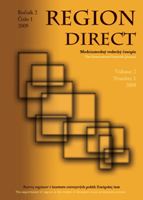Support Policy in Old Industrial Regions
Podporná politika v regiónoch ekonomického jadra
Author(s): Peter DžupkaSubject(s): Economy
Published by: Regionálne európske informačné centrum Banská Bystrica
Keywords: podporná politika; inovačná politika; regióny ekonomického jadra;
Summary/Abstract: This paper is result of the theoretical research made within “Regional dimensions of the knowledge economy” (REDIPE) project. The aim of this paper is to deal with support policy in old industrial regions from theoretical point of view. Just like there are trends in changing of economies to knowledge based economies, there are similar changes in support policies. Policies are changing in focus, tools and goals used. Therefore we analyze several theoretical works, studies and case studies with aim to answer following questions: − What is the appropriate level for innovation policy? − Is support policy more ex-post coordinated or pro-active? − Is policy more focused on indirect support (basic infrastructure, tax support etc.) or directly on dynamic knowledge (clusters, support services etc.)? There exist several types of support policies on regional level. When we want to investigate how the support policy of technology development was changing on regional level, probably the best type of the support policy will be the “Innovation policy” Innovation policy is combination of the research, technology and industrial policy. According to several authors the regionalization of the innovation system is the key element. (Edquist Ch. 1999, Kuhlman S. 2001, Todtling, Tripple 2004, Kutvonen A. 2007). Using innovation policy on regional level can have different results in different types of regions. According to (Keating M., 1998) regions with its own political system, decisions competencies and ability to claim theirs “regional interests” can gain from regionalization much more than regions with lower level of independents. By defining relationship between national and regional policy there are, from theoretical point of view, two basic approaches (or theirs combination) – bottom-up and top-down approach. In innovation policy theory is move to bottom-up approach very visible. Timing and promoting of the policy leads to question about the support policy as pro-active or ex-post coordinated. Methods and tools depends a lot on political autonomy of the region, on structure of the national policy, level of country development, industrial structure of the region etc. When investigation development of the innovation policies within EU coutries, a move from ex-post coordinated policies to pro-active policies is visible. Next question is, weather the innovation policy directly support the knowledge dynamics (consultation, clusters etc.) o it has a character of indirect support (basic infrastructure, taxis etc.) Tools used, are very closely connected to focus of the innovation policy. More authors (Morgan K. 1997, CEC 1994) state that first EU innovation support programmes were focused on solving the problem of offer side. Used tools were stimulating innovation offer through the innovation infrastructure building. In many cases it leads to „cathedral on the desert“ paradox.
Journal: Region Direct
- Issue Year: 2009
- Issue No: 1
- Page Range: 170-186
- Page Count: 17
- Language: Slovak

